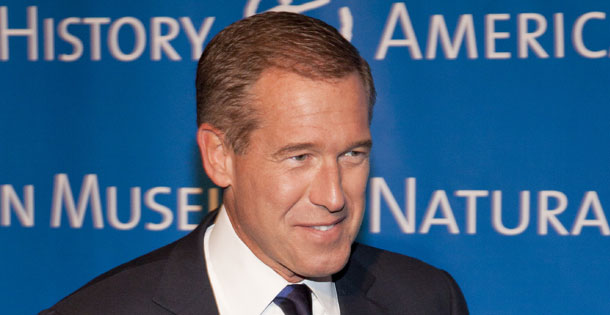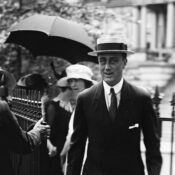Back in my newspaper reporter days we had a name for reporters who exaggerated details in a story: We called them “pipe artists,” and the stories they produced were “pipeski.” I think the phrase was derived from pipe dreams, which in turn is a reference to opium-induced fantasies. Whatever its origin, I discovered when I moved on to TV, no one used — or even knew — the expression.
Too bad: Broadcasting really needs a term for Brian Williams and his Choppergate misadventure. Who knew he was a pipe artist? And now that we know he invented a story about being in a helicopter that took enemy fire in Iraq, we must all wonder how much of his work over the years has been infected with pipeski. And beyond that, why was there pressure for him to embellish in the first place?
The answer to that may lie in the nature of the medium. A network half-hour newscast contains only 22 minutes of content — the other eight minutes are filled with commercials. Thus, competition among reporters for those precious minutes is fierce. There are more stories than there are minutes to accommodate them, so correspondents need to advocate for their stories. Part of a producer’s job is to separate the salesmanship from the journalism, discard the former and go with the latter.
But producers are only human and they tend to cut star reporters — especially those being groomed for the anchor slot — more than a little slack. In fact, the presence of a star reporter, in the minds of many producers, makes a story more important and thus more worthy of airtime.
When I was executive producer of Good Morning America, the network assigned us a correspondent who had been a star reporter at a local ABC station. He was our “on the go” guy, but I had a problem with him because I knew him to be a pipe artist. He had faked a combat incident in one of Israel’s many wars with its Arab neighbors (although he fooled his bosses at the local station) and so I accepted him on the show with great reluctance.
He sold stories to me with vigor. Every story he covered was the most important story of the day, if not the decade. And if I responded with a dubious lifted eyebrow, the details of the story got more and more dramatic. It was a constant struggle to keep his reports within the bounds of journalistic ethics. The audience, by the way, loved him.
Which brings us to Brian Williams, a smooth, self-assured anchor with a ready wit. He seemed to combine Peter Jennings’ panache with Walter Cronkite’s gravitas, spiced with a hint of David Brinkley’s humor. But now his mistake reveals a fabulist with a self-aggrandizing streak, an anchorman who brought the sensibilities of barroom bragging to his newscast.
No one contests that Williams — when he was a correspondent for, but not yet anchor of NBC’s Nightly News — flew in a U.S. military helicopter in Iraq in 2003. But it was another helicopter, in another formation, that was sufficiently damaged by an RPG — a rocket-propelled grenade — to force it into an emergency landing at a tiny U.S. enclave in the desert known as Rams Base. In the news report that aired shortly afterward — the first time he told the story — Williams acknowledged the downed Chinook helicopter was a different vehicle. But there was some exaggeration even then: Williams’ report gave the mistaken impression that his Chinook was in the same formation and was flying the same mission as the RPG-damaged chopper, and that the one he was in had taken ground fire. Pilots later said it hadn’t.
A few years ago, Williams went on the Late Show with David Letterman and retold the helicopter story, only this time he was a passenger in the RPG-struck aircraft. And then last week, on his own show the version of the story that had him in the RPGed Chinook was repeated. The helicopter’s crew took to Facebook to vent their anger about the misrepresentation. Stars and Stripes, the military newspaper, picked up the story and found other crew members who criticized Williams’ account.
Faced with the facts, Williams went on the air and apologized. Apparently, he said, he had conflated being a passenger in a helicopter that had taken fire with being in a helicopter so badly damaged it was forced down. The fog of war and a dozen-year-old memory were his excuses.
That doesn’t wash. You conflate the restaurant you ate in last month with the one you ate in two months ago; you don’t conflate a life-threatening situation with a weather-related aborted helicopter ride. The original 2003 news report was only slightly factually wrong, but Williams had expanded on that inaccurate tale. And now witnesses are coming forward claiming that he injected fabulist elements into his award-winning coverage of Hurricane Katrina’s aftermath. Among other things, he reported flooding in the French Quarter — where he was staying, although it was one of the neighborhoods in the crescent city that was spared flood damage. He also gave shifting accounts of whether he heard about or witnessed a suicide in the Superdome.
Why would a news correspondent jeopardize his career by exaggerating a story? What was wrong with “After we were forced down by a sand storm, we met the crew of a similar helicopter that had been shot down?” And why jeopardize a multi-million dollar anchor chair by adding more fictional elements to the story?
If you ever belly up to the bar with correspondents who have been to war, they will tell stories. And sometimes these encounters wind up as “can you top this” contests where facts may get gilded with light fiction. But the ethical ones leave that stuff in the barroom, even when they are selling their stories to editors and producer. And they certainly keep it out of the newspaper and off the air.
But even if a good journalist is supposed to check his ego — and his fictions — at the door to the newsroom, TV strokes egos like no other medium. And no ego gets stroked as much as an anchor’s. Perhaps Williams, feeling diminished because he wasn’t in a Chinook that took enemy fire, just put himself there.
Or maybe he was trying to live up to the impossible-to-match tradition of Edward R. Murrow, who flew a very dangerous mission over Berlin during World War II in an RAF bomber named D-Dog. Read Murrow’s amazing 19-minute report. Even better, hear Murrow deliver it.
Murrow didn’t report D-Dog to aggrandize himself — it was very clear to him the high price that could be exacted for we-were-there reports. In the next-to-the last paragraph of his story, he tells his audience: “There were four reporters on this operation. Two of them didn’t come back. Two friends of mine, Norman Stockton of Australian Associated Newspapers, and Lowell Bennett, an American representing International News Service. There is something of a tradition amongst reporters, that those who are prevented by circumstances from filing their stories will be covered by their colleagues. This has been my effort to do so.”
Murrow’s D-Dog sets a high bar for war reporting. But there is a much lower bar that is the very least this profession asks for — truth and accuracy. The pipe artist wiggles under that low bar. The highly motivated but ethical journalist will clear the bar. Pipe artists and ethical journalists share a trait: They are ambitious. If they weren’t they wouldn’t be in the profession. But ethical journalists understand that facts are what distinguish, not the sheen they try to put on them.
Originally published at Zócalo Public Square (zocalopublicsquare.org).
Become a Saturday Evening Post member and enjoy unlimited access. Subscribe now




Comments
I’m sure that Scott Pelley (CBS) and David Muir (ABC) aren’t about to let anything like this ever happen to them. I also doubt Brian Williams will be back in Nightly News anchor chair in 6 months. Only time will tell, but it seems unlikely.
What about the supposed human rights advocate and “efficacious collaborator” with the military during the Argentine “dirty war” Horacio Verbitsky, who continues to get preferential treatment by The New York Times, Washington Post, etc.? … https://www.linkedin.com/pulse/20141113035103-7893137-pope-francis-and-some-still-dirty-secrets-from-argentina-s-dirty-war